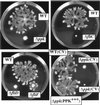Inorganic polyphosphate is needed for swimming, swarming, and twitching motilities of Pseudomonas aeruginosa
- PMID: 10758151
- PMCID: PMC18327
- DOI: 10.1073/pnas.060030097
Inorganic polyphosphate is needed for swimming, swarming, and twitching motilities of Pseudomonas aeruginosa
Abstract
Polyphosphate kinase (PPK), encoded by the ppk gene, is the principal enzyme in many bacteria for the synthesis of inorganic polyphosphate (poly P) from ATP. A knockout mutant in the ppk gene of Pseudomonas aeruginosa PAO1 is impaired in flagellar swimming motility on semisolid agar plates. The mutant is deficient in type IV pili-mediated twitching motility and in a "swarming motility" previously unobserved in P. aeruginosa. In swarming cultures, the polar monotrichous bacteria have differentiated into elongated and polar multitrichous cells that navigate the surface of solid media. All of the motility defects in the ppk mutant could be complemented by a plasmid harboring the ppk gene. Because bacterial motility is often crucial for their survival in a natural environment and for systemic infection inside a host, the dependence for motility on PPK reveals important roles for poly P in diverse processes such as biofilm formation, symbiosis, and virulence.
Figures





References
-
- Kulaev I S. The Biochemistry of Inorganic Polyphosphates. New York: Wiley; 1979. - PubMed
-
- Kornberg A, Rao N N, Ault-Riche D. Annu Rev Biochem. 1999;68:89–125. - PubMed
-
- Rao N N, Kornberg A. In: Progress in Molecular and Subcellular Biology. Schroder H C, Muller W E G, editors. Vol. 23. Heidelberg: Springer; 1999. pp. 183–195. - PubMed
Publication types
MeSH terms
Substances
LinkOut - more resources
Full Text Sources
Other Literature Sources

